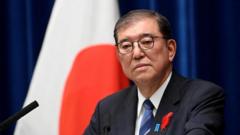The Japanese electorate went to the polls on Sunday in a highly competitive election, prompted by growing public discontent over soaring prices and looming threats from the United States regarding tariffs. The ruling Liberal Democratic Party (LDP), along with its coalition partner Komeito, must secure a total of 50 seats in the upper house to maintain their governing majority, but recent polls indicate they are likely to fall short of this target.
Prime Minister Shigeru Ishiba and his coalition face significant challenges amid rising tensions with US President Donald Trump, who has intensified pressure on Tokyo during ongoing tariff negotiations. Japan's vital auto sector, which supports approximately eight percent of the domestic job market, is already suffering from existing tariffs.
Recent reportsof weak export data have heightened concerns that Japan, the fourth-largest economy globally, could be on the verge of a technical recession. Ishiba's attempts to negotiate a resolution have yet to bear fruit, with no trade agreement reached despite his meetings with Trump and multiple trips by his trade representative to the US.
Rising living costs also weigh heavily on voters’ minds, particularly as the price of rice—a staple in Japanese households—has surged nearly 100% over the past year. To manage the situation, the government has had to rely on its emergency stockpiles. Since the last lower house elections, which saw the coalition fail to grasp a majority, the LDP has struggled to regain voters' trust, who remain frustrated with stagnant wages coupled with persistent inflation.
A populist party, Sanseito, has gained traction by appealing to younger demographics through social media. Their platform, which includes a call for "stricter rules and limits" on immigration, has resonated with some conservative voters despite criticisms of their hardline stance on foreign issues and skepticism towards globalism and progressive gender policies.
Should Ishiba's ruling coalition fail to obtain at least 50 seats, they would lose their majority in both parliamentary chambers, a scenario that could jeopardize his leadership and lead to political upheaval. The LDP and Komeito have been the prevailing political force in Japan since 1955, notwithstanding frequent leadership changes. The last observed failure to achieve an upper house majority occurred in 2010, following which Japan experienced a notable government transition in 2009 with the Democratic Party of Japan briefly taking control.
Prime Minister Shigeru Ishiba and his coalition face significant challenges amid rising tensions with US President Donald Trump, who has intensified pressure on Tokyo during ongoing tariff negotiations. Japan's vital auto sector, which supports approximately eight percent of the domestic job market, is already suffering from existing tariffs.
Recent reportsof weak export data have heightened concerns that Japan, the fourth-largest economy globally, could be on the verge of a technical recession. Ishiba's attempts to negotiate a resolution have yet to bear fruit, with no trade agreement reached despite his meetings with Trump and multiple trips by his trade representative to the US.
Rising living costs also weigh heavily on voters’ minds, particularly as the price of rice—a staple in Japanese households—has surged nearly 100% over the past year. To manage the situation, the government has had to rely on its emergency stockpiles. Since the last lower house elections, which saw the coalition fail to grasp a majority, the LDP has struggled to regain voters' trust, who remain frustrated with stagnant wages coupled with persistent inflation.
A populist party, Sanseito, has gained traction by appealing to younger demographics through social media. Their platform, which includes a call for "stricter rules and limits" on immigration, has resonated with some conservative voters despite criticisms of their hardline stance on foreign issues and skepticism towards globalism and progressive gender policies.
Should Ishiba's ruling coalition fail to obtain at least 50 seats, they would lose their majority in both parliamentary chambers, a scenario that could jeopardize his leadership and lead to political upheaval. The LDP and Komeito have been the prevailing political force in Japan since 1955, notwithstanding frequent leadership changes. The last observed failure to achieve an upper house majority occurred in 2010, following which Japan experienced a notable government transition in 2009 with the Democratic Party of Japan briefly taking control.




















